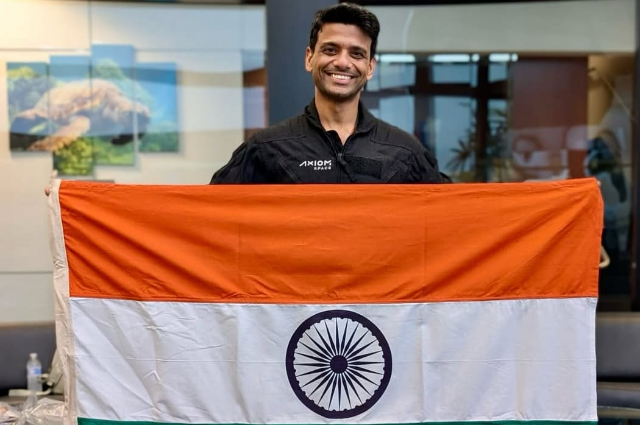
‘Saare Jahan se Achha!’
These were the iconic words Indians heard in 1984, when Rakesh Sharma described how India looked from space. 41 years since, Shux, i.e., Shubhanshu Shukla, became just the second Indian to venture into space. His journey, besides being a personal triumph, was an epic moment for India’s space ambitions as the country eagerly waits for the Gaganyaan mission to be launched. To understand why this mission mattered, let’s look at the journey, the results, and where India and the world stand as we look towards a cosmic future.
The Axiom Mission and Shux’s Role
Axiom Space, a private space company working with NASA and SpaceX, launched the Axiom Mission 4 (Ax-4) on 25th June 2025, using a SpaceX Falcon 9 rocket from the Kennedy Space Centre in Florida. The mission carried four astronauts to the International Space Station (ISS) for a fourteen-day stay. The crew included:
- Peggy Whitson (USA), a veteran astronaut and mission commander.
- Slawosz Uznanski-Wisniewski (Poland), a scientist from the European Space Agency.
- Tibor Kapu (Hungary), representing Hungary’s space program.
- Shubhanshu Shukla (India), serving as the mission’s pilot and representing India’s space program.
Originally planned for launch on 19th June 2025, the SpaceX spacecraft faced a few technical and physical snags before finally being ready for launch by 25th June 2025. The crew had planned a fourteen-day stay wherein they would live and experiment in microgravity. Shubhanshu Shukla’s role, in particular, was to conduct over 60 experiments besides piloting the spacecraft. His presence showed that Indian astronauts can now be part of important missions, not only as guests, but also as active contributors to space explorations.
Shubhanshu Shukla, bringing India’s spirit into space, also took with him ‘aam rass’, ‘moong dal halwa’, and ‘gajjar ka halwa’ to carry a taste of home. He also spoke with Prime Minister Narendra Modi and answered questions from school students, making the nation nostalgic as it remembered similar moments from Rakesh Sharma’s visit. He even reiterated Rakesh Sharma’s legendary words.
‘Even today, Bharat looks saare jahan se achha.’
The crew’s return was planned for 10th July, but it got postponed by four days due to unfavourable positioning of the ISS, which didn’t permit a smooth re-entry into the Earth’s atmosphere. They finally undocked on 14th July and splashed down successfully on 15th July, completing an 18-day mission.
Why the Mission Matters for India’s Space Ambitions
India is eyeing a historic first manned space mission named Gaganyaan, which is set to be launched in 2027. Shubhanshu Shukla is one of the four astronauts selected for the mission, which proves why the Axiom mission can be seen as a rehearsal before the much bigger project. Shux’s visit to space allowed him to gather as much knowledge and experience as possible, which would be valuable for Gaganyaan’s successful launch. This explains why India spent over 548 crore rupees in training, launch arrangements, travel, and research work done by Shukla.
Shubhanshu Shukla conducted seven experiments that would help ISRO to plan and build Gaganyaan’s spacecraft. For eg, Shux grew methi and moong seeds, studied muscle regeneration, microalgae, tardigrades, and also how the human body reacts to microgravity. His work truly gave India a strong voice in global space research!
By flying on a commercial mission with NASA, SpaceX, and Axiom Space, Shukla also helped India strengthen its ties with global space agencies. The Chandrayaan III mission increased India’s stature in the world, and missions like Shux’s further prove why India is ready to collaborate, contribute, and lead humanity’s future in space. Shukla’s journey sparked national pride and curiosity, making him a national hero as his story inspires aspirants to dream big.
India and the World in Orbit
India’s space journey has come a long way, from launching rockets using bicycles to planning to launch a manned mission all on its own and even a space station by 2035. India’s achievements include:
- Mangalyaan (2014), wherein India reached Mars on the first attempt itself.
- Launched 104 satellites in one mission (2017), which is a world record.
- Chandrayaan III, wherein India became the first country to reach the south pole of the moon.
But Shubhanshu Shukla’s flight wasn’t just a national glory, but a boost to the entire world’s efforts to explore space. Just as Shubhanshu Shukla’s flight was a turning point for India, the other crew members represented historic milestones for their countries too:
- Slawosz Uznanski-Wisniewski’s flight alongside Shux marked Poland’s comeback in space after 47 years! Like Shubhanshu Shukla, his iconic words before launch, ‘I represent all of us,’ sparked national pride, and his experiments in radiation biology, brain-computer interfaces, and astronaut health will help Poland in its space programs.
- Tibor Kapu, on the other hand, became the first ever Hungarian to visit the ISS. He conducted 25 experiments like DNA repair, brain function, and space agriculture in microgravity. His journey is seen as a symbol of Hungary’s scientific revival.
Besides this mission, countries like the United Arab Emirates, Italy, Japan, Canada, China, Russia, and even Rwanda are designing, building, and launching satellites and rockets. This shows how the world is collaborating and why space exploration is no longer limited to a few superpowers.
Conclusion
The Axiom Mission 4 was a global effort with Hungary, Poland, India, and the USA working together and sharing valuable results and insights from the mission with the world. For India, Shubhanshu Shukla’s flight honoured the legacy of Rakesh Sharma and opened doors for many more Indians to fly to space. This trip was another milestone in India’s efforts to establish itself as a superpower. This mission proved that when countries work together, it's not just about rockets. It's about ideas, hopes for a better future, and humanity in general!
